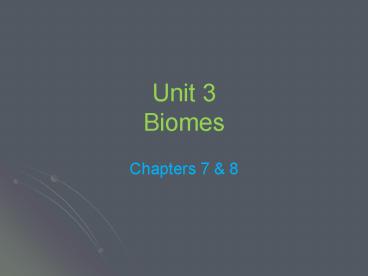Unit 3 Biomes - PowerPoint PPT Presentation
1 / 44
Title:
Unit 3 Biomes
Description:
Unit 3 Biomes Chapters 7 & 8 Ocean Currents Redistribute solar energy Influence climate and vegetation Mixes water to redistribute nutrients and dissolved oxygen (DO ... – PowerPoint PPT presentation
Number of Views:64
Avg rating:3.0/5.0
Title: Unit 3 Biomes
1
Unit 3Biomes
- Chapters 7 8
2
Weather
- ______________ atmospheric conditions
- Over __________________
3
How do we describe weather?
- Temperature
- Pressure
- Moisture content
- Precipitation
- Sunshine
- Cloud cover
- Wind speed and direction
4
Weather equipment
- Balloons
- Satellites
- Aircraft
- Ships
- Radar
- Sensors
- Computer models
5
Weather Maps
Isotherms thin black lines that separate areas
of different temperatures
6
(No Transcript)
7
- Isobar thick lines that connect points with the
same barometric pressure. - High-pressure system (red "H)
- Low-pressure system (blue "L)
- Cold front (blue line with triangles) The
triangles point in the direction toward which the
cold front is moving. - Warm front (red line with semi-circles) The
semicircles point in the direction toward which
the warm front is moving. - Stationary front These are shown on weather maps
as alternating triangles and semicircles.
8
(No Transcript)
9
How does weather change?
- When air masses meet at a front
- Front-
10
Weather Fronts
- Cold Fronts (associated w ____________)
- Edge between an advancing _____ air mass a
__________ one - More dense
- Lower to ground
- Faster moving
- Wedge up under the warmer air mass
- Shifts winds from southeast to northwest
- Causes storms cooler temperatures
11
Weather Fronts
- Warm Fronts (associated with ____________________)
- Edge between advancing ________ air mass a
___________ one - Less dense
- Causes fog if stable
- Shifts winds from southeast to southwest
- Causes light rain warmer temperatures
12
Air Pressure
- Caused by gas molecules moving around the
atmosphere
13
Low Pressure
- Wind circulates _____________________ around
low-pressure systems in the northern hemisphere
(opposite in the southern hemisphere) - Center of the mass rises, expands and cools down
14
High Pressure
- Wind circulates _____________________ around
high-pressure systems in the northern hemisphere
(opposite in the southern hemisphere)
15
Jet Streams
- Powerful winds in upper ______________
- Strongly influence weather patterns
16
Dew Point
- The temperature where water vapor condenses and
becomes liquid - Associated with relative humidity
17
Tornadoes
- Swirling funnel clouds that form over land
18
Tornadoes
- Forms from a cumulonimbus
- touch the ground
- Winds
- Travel only
19
Tornado Alley
- Large, dry, cold air front from Canada moves
south and interacts with a large humid mass
travelling north from Gulf of Mexico - Large warm air mass moves rapidly over the dense
cold air - Warm air rises rapidly and causes vertical
convection currents to form that sucks the air up
20
(No Transcript)
21
Tornadoes
- (Enhanced) Fujita Scale
22
Tropical _________________
- Low pressure air masses over
- Long time to form and strengthen
- Easy to track
??? ?
23
Hurricane or Typhoon?
- Hurricanes form in the
- Typhoons form in the
????
24
Hurricane Formation
25
Hurricanes
- Warm moist air spiral into the center of the
storm and are sucked upward - Rising air cools and leaves the storm at high
altitudes
26
(No Transcript)
27
Climate
- ____________________ atmospheric conditions
- Average
- Average
- Varies due to
28
Factors in Air Circulation
- 1. Uneven _________________ of the Earths
surface - Directly hits equator
- Hits poles at an angle
- 2. ______________________________ in temperature
and precipitation
29
Factors in Air Circulation
- 3. _______________________________
- Surface turns faster at the equator and slower
at the poles - Causes winds to deflect (___________)
30
Factors in Air Circulation
- 4. Properties of air, water, and land affect
circulation - How land, water, and air heat differently
- Convection
31
Convection
- Hot air is less dense, it
- Cool air is more dense, it
32
Convection Cells
- Directly influence air and water currents
33
Ocean Currents
- Warm air moves over the surface of the water
transfers energy to the water - Ocean water has different densities due to
differences in ______________ _________________ - Combine to create __________________
34
Ocean Currents
- Redistribute solar energy
- Influence climate and vegetation
- Mixes water to redistribute nutrients and
dissolved oxygen (DO)
35
Upwelling
- Cool, nutrient rich waters are drawn
______________ to replace warm surface waters - Surface waters are usually displaced by wind
- Bring ______________ to shallow regions
36
Upwelling
37
ENSO
- El Niño Southern Oscillation
- 1997-1998 El Nino Event
- Can cause extreme global weather changes
38
La Niña
- Opposite of ENSO
- Causes more hurricanes, colder winters, wildfires
in FL
39
Greenhouse Effect
40
Greenhouse Effect
- Solar energy enters the atmosphere
- Solar energy hits something on the Earths
surface and passes some of that energy to the
object - Solar energy tries to escape the atmosphere but
no longer has enough energy so it is trapped
41
Greenhouse Effect
- Humans are adding greenhouse gases through
activities such as driving cars, burning fossil
fuels, cutting down trees
42
Greenhouse Gases
43
Rain Shadow Effect
44
Rain Shadow Effect
- Warm moist air hits a
- Air is forced upwards where it cools and is
forced to release its moisture - Creates one side of the mountain that has
- Other side of mountains are































